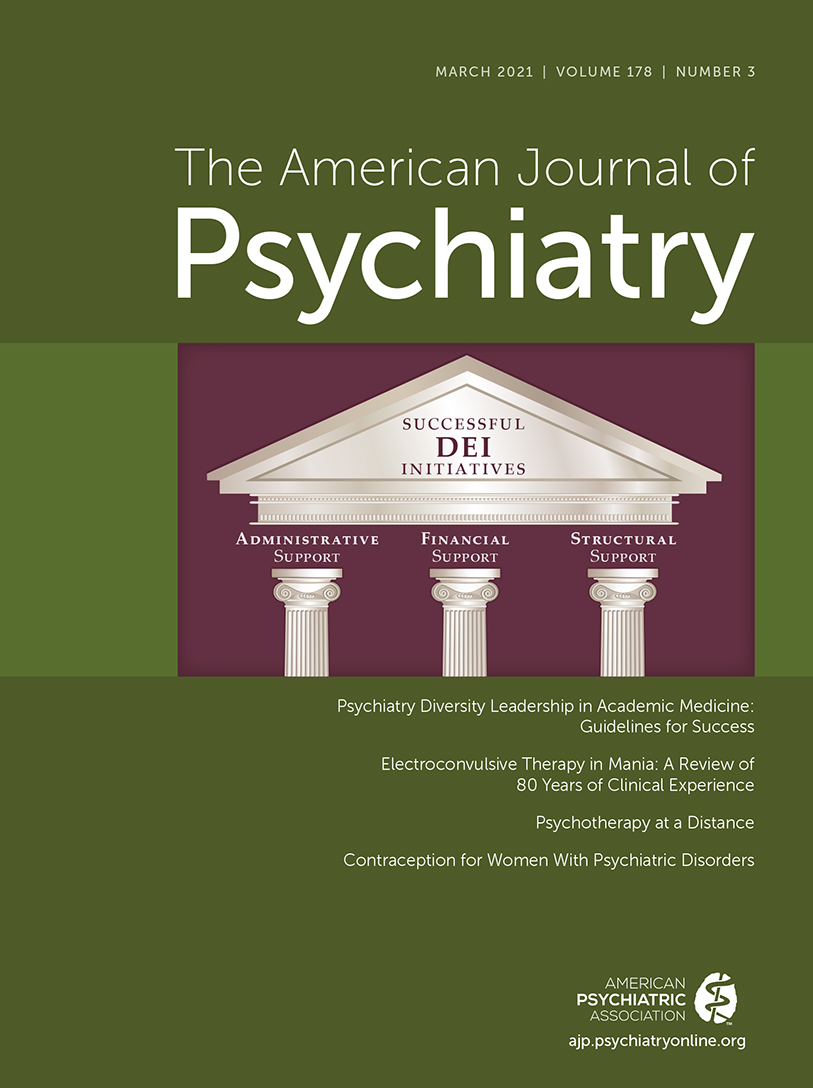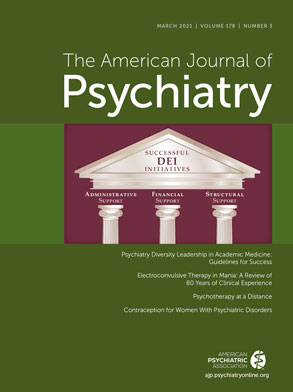Aggression is an important negative outcome, and its prediction and prevention are among the top priorities in psychosis care. In their contribution in this issue of the
Journal, Krakowski et al. (
1) compare the effects of antipsychotics on violent schizophrenia patients with and without comorbid conduct disorder. As expected, patients with a history of comorbid conduct disorders had more frequent and severe physical assaults compared with patients without conduct disorders. Interestingly, clozapine and olanzapine had more pronounced antiaggressive effects compared with haloperidol in patients with conduct disorders than in patients without this comorbidity. We put this new, important finding into perspective.
The exact magnitude of the problem at hand is not completely clear because studies use different definitions, methods, populations, and settings. In a 38-year follow-up study that included the total population in Sweden, the adjusted odds ratio for convictions of any violent offense—including homicide, sexual offenses, assault, and intimidation—in patients with psychotic disorders (N=24,297) was 7.4 (95% CI=7.1–7.8) compared with the general population (
2). A recent study in two U.K. regions that used police data of patients with first-episode psychosis (N=177) found that 14.7% were arrested or charged for violent offenses within 12 months after their first contact with specialized mental health care (
3). In contrast to increased rates of violence, patients with psychotic disorders are also more vulnerable for victimization. A meta-analysis found that 20% of patients with psychotic disorders reported violent victimization over a 3-year period, some five times higher than in the general community (
4). For a national census in Norway, mental health clinicians performed an unstructured risk assessment on inpatients and outpatients in psychiatric treatment, which included 60%−65% of all patients. Risk was rated as none, low to moderate, high, or very high. Results showed that 7% of outpatients and 27% of inpatients were considered to be at low to moderate risk and that 5% of inpatients and less than 1% of outpatients were at high or very high risk (
5). These risk assessments are considerably lower than the actual odds ratio for violent offenses, indicating a gap between estimated risk and actual occurrence of violence, yet reliable identification of patients at risk is crucial in the prevention of aggression. Several recent studies present interesting findings on risk factors.
First, a 6-year follow-up study of patients with psychotic disorders confirmed earlier studies that childhood trauma is a risk factor for aggression (hazard ratio=1.74, 95% CI=1.03–2.93) (
6). Another important and well-known childhood risk factor, conduct disorder, was confirmed in the article by Krakowski et al. (
1). Interestingly, Oakley et al. (
7) found that conduct disorder was associated with childhood adversities and with later violence among a sample of 54 male patients with schizophrenia. The authors therefore suggested that there is a complex interplay between childhood adversity, conduct disorder, and later violent behavior in psychotic disorders (
7).
Second, substance abuse has long been confirmed as an important risk factor for aggression. Lamsma et al. (
8) synthesized two nationwide psychosis studies from the United Kingdom and the Netherlands. Compared with nondaily or no illicit drug use, daily use of cannabis (pooled odds ratio=1.6, 95% CI=1.2–2.0), stimulants (pooled odds ratio=2.8, 95% CI=1.7–4.5), and sedatives (opiates and inhalants) (pooled odds ratio=2.2, 95% CI=1.1–4.5) all increased the risk for violence (
8). Kalk et al. (
9) analyzed data of first-time admitted patients in an emergency psychiatric detention facility in the United Kingdom (N=1,089) and found that psychotic symptoms combined with recent cannabinoid use largely increased the risk for aggression (odds ratio=7.1, 95% CI=3.7–13.6). The risk was also increased, but to a lesser extent, among patients without psychotic symptoms but with recent use of both cannabinoids and stimulants (odds ratio=3.3, 95% CI=1.4–7.9).
Third, results from a cohort study in Switzerland that included patients with first-episode psychosis (N=265) confirmed that impulsivity increased the risk for violence (odds ratio=1.53, 95% CI=1.22–1.93), although not spectacularly. This relationship was not mediated by substance abuse (
10). In more chronic psychotic disorders, 26% of the safety needs related to aggression were attributable to impulsivity 3 years earlier, assuming causality (
6).
Fourth, Buchanan et al. (
11) recently analyzed data from the Clinical Antipsychotic Trials of Intervention Effectiveness (CATIE) trial, in which patients with schizophrenia (N=1,435) were followed for 18 months, and found that medication nonadherence was related to injurious violence (hazard ratio=1.39, 95% CI=1.04–1.86). Other risk factors in this study included recent violent victimization (hazard ratio=3.52, 95% CI=1.62–7.64) and severity of illicit drug abuse (hazard ratio=2.93, 95% CI=1.65–5.18).
Interpretation of Risk
Most studies focus on individual risk factors, while aggression is contextual and relational. Moreover, risk factors are most interesting for clinical practice when they are causal and modifiable, but the relationship between a risk factor and aggression is usually not straightforward. Risk factors interact with each other and with aggression. Recently, Adams and Yanos (
12) proposed a practical model that included psychosocial factors such as victimization and situational stressors, discrimination, social rejection, and hostile attributions. These pathways affect the interplay between psychotic symptoms, anger, and aggression, further increased by substance abuse and impulsivity.
An important practical measure is to interpret and discuss the risk for aggression with the patient, as it is also in the patient’s interest to prevent aggressive behavior. The patient can give views on etiology, triggers, and contributors to aggression. The patient’s family is a major source of information because of their experience with the patient. Ideally, the clinician, patient, and family determine in shared decision making if aggression should be a focus of treatment. This does, however, depend on the patient’s cooperation and insight.
Prevention
The most effective prevention highly depends on the origins and etiology of the aggression. Nonpharmacological options have not been studied as extensively as pharmacological interventions. Interventions specifically aimed at aggression reduction are often derived from offender populations. A systematic review found promising interventions, such as cognitive-behavioral therapies and cognitive skills programs focused on reasoning and rehabilitation, but there is insufficient evidence as to whether these are also effective in nonoffender populations with severe mental illness (
13). A practical solution is to treat modifiable and causal risk factors or exacerbating behaviors. For example, treatment of impulsivity could decrease aggression risk, assuming causality, but specific and evidence-based interventions are needed (
10). Likewise, trauma-informed treatment of aggression could be suitable if trauma is a perceived cause of aggression, but there is currently insufficient evidence for its efficacy (
12).
As for pharmacological interventions, benzodiazepines are often used to prevent upcoming escalation. A recent systematic review on the effectiveness of benzodiazepines for psychosis-induced aggression included 20 trials (N=695) comparing either benzodiazepine add-on to placebo or benzodiazepine to antipsychotic medication; however, most of these studies had low sample sizes and serious risk for bias due to problems with randomization and blinding (
14). Despite these drawbacks, there was no apparent advantage of benzodiazapines over antipsychotic medication, and the addition of benzodiazepines showed efficacy in only one study. For persistent aggression in psychotic disorders, antipsychotics and, specifically, clozapine are an effective choice (
15). In the Krakowski et al. (
1) article, the authors compare clozapine, olanzapine, and haloperidol. This is a high-quality study, which is rare in this field, as an overt aggression scale is used, while most other studies use an indirect measure of aggression, such as the hostility item of the Positive and Negative Syndrome Scale. Also, all patients were admitted to a research ward, allowing close observation and equivalent circumstances for all patients, including no access to illicit drugs. The authors found that clozapine was superior to haloperidol and olanzapine and that olanzapine was superior to haloperidol. This effect was stronger for patients with conduct disorder compared with patients without conduct disorder. Olanzapine was not significantly superior to haloperidol in patients without conduct disorder. These results are consistent with our meta-analysis showing that atypical antipsychotics are more effective against hostility compared with typical antipsychotics, and clozapine had the highest effect size (
15).
As treatment nonadherence is a risk factor for aggressive behavior (
11), long-acting injectables could have advantages over oral antipsychotics (
16), which are available for olanzapine but not for clozapine. Other strategies to improve treatment adherence could help, as Drake et al. (
17) showed that motivational interviewing, online psychoeducation, and text-message reminders are effective ways to enhance adherence.
Conclusions
Aggression is heterogeneous and common in patients with psychotic disorders. Risk should be interpreted carefully, preferably together with the patient and family, and should include evaluations of triggering factors, history of trauma and/or victimization, impulsive behavior, substance abuse, medication adherence, and presence of conduct disorder. As Krakowski et al. (
1) show, clozapine and olanzapine are effective against aggression in patients with schizophrenia and have more pronounced antiaggressive effects in patients with comorbid conduct disorders. There is insufficient evidence for nonpharmacological treatment options, but such treatment represents an interesting area for further research.

